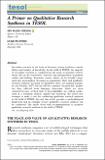Files in this item
A primer on qualitative research synthesis in TESOL
Item metadata
| dc.contributor.author | Chong, Sin Wang | |
| dc.contributor.author | Plonsky, Luke | |
| dc.date.accessioned | 2022-02-18T13:30:10Z | |
| dc.date.available | 2022-02-18T13:30:10Z | |
| dc.date.issued | 2021-10-24 | |
| dc.identifier | 277616948 | |
| dc.identifier | 39df1456-c41c-48c3-988f-fc1f1c8d7575 | |
| dc.identifier | 85106603395 | |
| dc.identifier.citation | Chong , S W & Plonsky , L 2021 , ' A primer on qualitative research synthesis in TESOL ' , TESOL Quarterly , vol. 55 , no. 3 , pp. 1024-1034 . https://doi.org/10.1002/tesq.3030 | en |
| dc.identifier.issn | 0039-8322 | |
| dc.identifier.other | Bibtex: 03bb3fc8ebc04060b5536839ea8d13b1 | |
| dc.identifier.other | ORCID: /0000-0002-4519-0544/work/107287435 | |
| dc.identifier.uri | https://hdl.handle.net/10023/24905 | |
| dc.description.abstract | Secondary research in the form of literature reviews facilitates consolidation and transfer of knowledge. In the field of TESOL, the majority of secondary research is conducted in the form of narrative reviews, which rely on the Plonsky’s selection and interpretation of primary studies and findings. Systematic reviews, which can be broadly categorized into meta-analysis (focusing on quantitative data) and qualitative research synthesis (focusing on qualitative data), are gaining popularity (see Plonsky, 2017) but are still less common. In particular, qualitative data collected from language classrooms, which are often criticized because of their lack of generalizability, are seldom synthesized in a systematic fashion. Against this backdrop, this article first attempts to make a case for conducting qualitative research synthesis in the field of TESOL. Second, this article provides a methodological framework and an example of how qualitative research synthesis can be conducted. The article closes with recommendations to promote qualitative research synthesis in the field of TESOL. | |
| dc.format.extent | 11 | |
| dc.format.extent | 260957 | |
| dc.language.iso | eng | |
| dc.relation.ispartof | TESOL Quarterly | en |
| dc.subject | LB2300 Higher Education | en |
| dc.subject.lcc | LB2300 | en |
| dc.title | A primer on qualitative research synthesis in TESOL | en |
| dc.type | Journal article | en |
| dc.contributor.institution | University of St Andrews. International Education Institute | en |
| dc.identifier.doi | 10.1002/tesq.3030 | |
| dc.description.status | Peer reviewed | en |
This item appears in the following Collection(s)
Items in the St Andrews Research Repository are protected by copyright, with all rights reserved, unless otherwise indicated.

